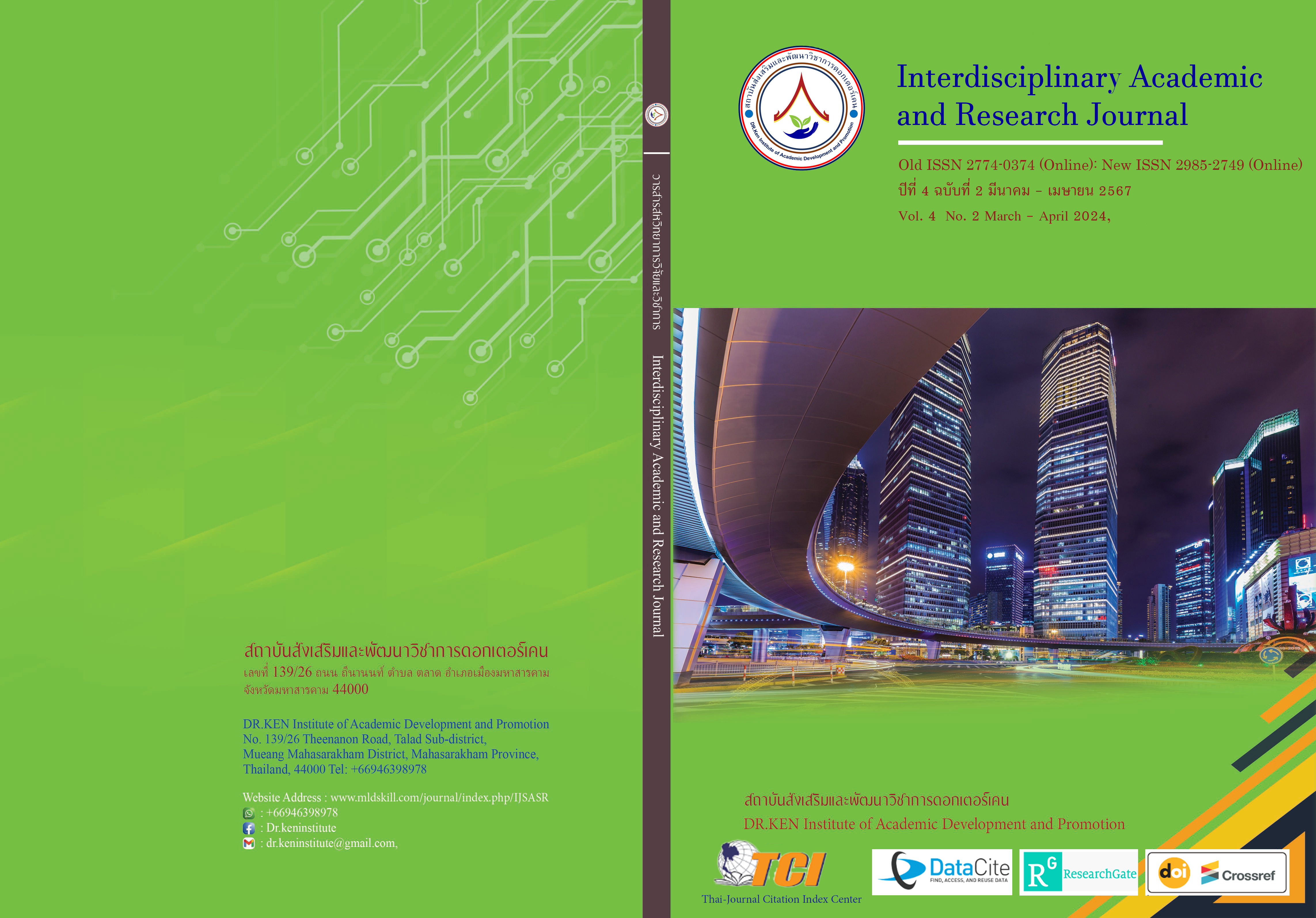การเปรียบเทียบปัจจัยภายนอกและปัจจัยภายในที่ส่งผลต่อการตัดสินใจเลือกประกอบวิชาชีพครู ของครูที่มีภูมิหลังต่างกัน
DOI:
https://doi.org/10.60027/iarj.2024.274665คำสำคัญ:
ปัจจัยภายนอก; , ปัจจัยภายใน; , การตัดสินใจ;, วิชาชีพครูบทคัดย่อ
ภูมิหลังและวัตถุประสงค์: การศึกษาถือเป็นส่วนที่สำคัญที่สุดประการหนึ่งของมนุษย์ ซึ่งองค์ประกอบสำคัญประการหนึ่งของการศึกษาคือครูที่นอกจากหน้าที่สอนแล้วผู้ประกอบวิชาชีพครูยังมีบทบาทในฐานะนักการศึกษาที่มีหน้าที่ให้ความรู้แก่คนรุ่นต่อไปของประเทศชาติ แต่การประกอบวิชาชีพครูยยังพบปัญหาเกี่ยวกับการคัดเลือก สรรหา หรือรักษาอัตราการคงอยู่ของครูในระบบ การวิจัยครั้งนี้จึงมีวัตถุประสงค์เพื่อ (1) ศึกษาระดับปัจจัยภายนอกและปัจจัยภายในที่ส่งผลต่อการตัดสินใจเลือกประกอบวิชาชีพครูของครูที่มีภูมิหลังต่างกัน และ (2) เปรียบเทียบปัจจัยภายนอกและปัจจัยภายในที่ส่งผลต่อการตัดสินใจเลือกประกอบวิชาชีพครูของครูที่มีภูมิหลังต่างกัน
ระเบียบวิธีการวิจัย: กลุ่มตัวอย่างที่ใช้ในการวิจัยคือครูโรงเรียนรัฐบาลและเอกชน ในกลุ่มเขตตะวันออก จำนวน 3 เขต ได้แก่ เขตมีนบุรี เขตหนองจอก และเขตสะพานสูง จำนวน 370 คน โดยใช้การสุ่มแบบหลายขั้นตอน เครื่องมือที่ใช้ในการวิจัยคือแบบสอบถาม วิเคราะห์ข้อมูลด้วยการวิเคราะห์ความแปรปรวนพหุสองทาง
ผลการวิจัย: (1) ปัจจัยภายนอกและปัจจัยภายในที่ส่งผลต่อการตัดสินใจเลือกประกอบวิชาชีพครูของครูที่มีภูมิหลังต่างกัน มีค่าเฉลี่ยอยู่ในระดับมาก (M=4.14, SD=0.53 และ M=4.41, SD=0.57 ตามลำดับ) และ (2) ครูที่มีวุฒิการศึกษาที่สำเร็จต่างกันมีระดับปัจจัยภายนอกและปัจจัยภายในที่ส่งผลต่อการตัดสินใจเลือกประกอบวิชาชีพครูแตกต่างกันที่ระดับนัยสำคัญ .05 ส่วนครูที่มียุคสมัยของกลุ่มคนตามช่วงอายุต่างกันไม่มีความแตกต่างกัน
สรุปผล: การวิจัยเน้นย้ำถึงผลกระทบที่สำคัญจากปัจจัยทั้งภายนอกและภายในต่อการตัดสินใจของครูในการประกอบอาชีพครูโดยไม่คำนึงถึงภูมิหลังที่หลากหลาย นอกจากนี้ อิทธิพลของปัจจัยเหล่านี้มีความแตกต่างกันอย่างมีนัยสำคัญในหมู่ครูที่มีคุณสมบัติทางการศึกษาที่แตกต่างกันโดยเฉพาะอย่างยิ่งอายุไม่ได้เป็นปัจจัยสำคัญในการตัดสินใจเข้าสู่วิชาชีพครูของแต่ละบุคคล
References
ข้อบังคับคุรุสภา ว่าด้วยจรรยาบรรณของวิชาชีพ พ.ศ. 2556. (2556, 4 ตุลาคม). ราชกิจจานุเบกษา. เล่ม 130 ตอนพิเศษ 130 ง. หน้า 72-74.
Chetty, R., Friedman, J.N., & Rockoff, J.E. (2014). Measuring the impacts of teachers II: Teacher value-added and student outcomes in adulthood. American Economic Review, 104 (9), 2633–2679.
Collie, R.J, & Martin, A.J. (2016). Adaptability: An important capacity for effective teachers. Educational Practice and Theory, 38(1), 27-39.
Domjan, M. (1996). The principles of learning and behavior. Thomson/ Wadsworth.
Gerritsen, S., Plug, E., & Webbink, D. (2017). Teacher quality and student achievement: Evidence from a sample of Dutch twins. Journal of Applied Econometrics, 32(3), 643–660.
Gibbs, P., & Griffin, P. (2013). Parental influence on career development in the early years. International Journal for Educational and Vocational Guidance, 13(1), 19–33.
Goldhaber, D., Theobald, R., & Fumia, D. (2018). Teacher quality gaps and student outcomes: Assessing the association between teacher assignments and student math test scores and high school course taking. Working paper 185. National Center for Analysis of Longitudinal Data in Education Research (CALDER).
Gunawan, J. (2017). Nursing and men: A gender bias. Belitung Nursing Journal, 3(1), 52-53.
Ingersoll, R. M. (2003). Who controls teachers’ work? Power and accountability in America’s schools. Harvard University Press.
Ingersoll, R. M., & Strong, M. (2011). The impact of induction and mentoring programs for beginning teachers: A critical review of the research. Review of Educational Research, 81(2), 201–233.
Johnson, S.M., & Birkeland, S.E. (2003). Pursuing a “Sense of Success”: New teachers explain their career decisions. American Educational Research Journal, 40(3), 581-617.
Krejcie, R.V., & Morgan, D.W. (1970). Determining sample size for research activities. Educational and Psychological Measurement, 30, 607 –610.
Kusumastuti, D. (2020). The analysis of a short story “Untuk Ibu”: Microstructural approach and practice of discourse. Journal of Languages and Language Teaching, 7(1), 38. https://doi.org/10.33394/jollt.v7i1.1437
Liu, E., Kardos, S.M., Kauffman, D., Preske, H.G., & Johnson, S.M. (2000). Barely breaking even: Incentives, rewards, and the high costs of choosing to teach. Harvard Graduate School of Education. http://www.gse.harvard.edu/wngt/Barely% 20Breaking%20Even%200700.PDF.
Lovell, R. E., (1980). Adult Learning. John Wiley and Sons.
Nawafil, M. 2018. Cornerstone of education: Landasan-Landasan Pendidikan. Absolute Media.
OECD. (2004a). Attracting, developing and retaining effective teachers. Organization for Economic Co-operation and Development. http://www.oecd.org/document/9/0,2340,en_2649_ 34521_11969545_1_1_1_1,00.html
OECD. (2004b). Attracting, developing, and retaining effective teachers. U.S. Department of education, international affairs office. Country background report for the United States. http://www.oecd.org/dataoecd/18/52/33947533.pdf
OECD. (2005). Teachers matter: Attracting, developing and retaining effective teachers. OECD Publishing.
OECD. (2011). Building a high-quality teaching profession: Lessons from around the world. Background report for the international summit on the teaching profession. OECD Publishing. http://asiasociety.org/files/lwtw-teachersummit.pdf
Ofsted. (2001). The annual report of her majesty’s chief inspector of schools: Standards and quality in education 2000. Office of Standards in Education.
Opfer, V. D., & Pedder, D. (2011). Conceptualizing teacher professional learning. Review of Educational Research, 81(3), 376–407.
Preston, B. (2000). Teacher supply and demand to 2005-projections and context. Australian Council of Deans: ACDE.
Ramsay, G. (2000). Quality matters. Revitalizing teaching: Critical times, critical choices. Report of the review of teacher education. NSW Department of Education and Training.
See, B.H., Morris, R., Gorard, S., & El Soufi, N. (2020). What works in attracting and retaining teachers in challenging schools and areas? Oxford Review of Education, 46(6), 678–697.
Downloads
เผยแพร่แล้ว
How to Cite
ฉบับ
บท
License
Copyright (c) 2024 Interdisciplinary Academic and Research Journal

This work is licensed under a Creative Commons Attribution-NonCommercial-NoDerivatives 4.0 International License.
ลิขสิทธิ์ในบทความใดๆ ใน Interdisciplinary Academic and Research Journal ยังคงเป็นของผู้เขียนภายใต้ ภายใต้ Creative Commons Attribution-NonCommercial-NoDerivatives 4.0 International License การอนุญาตให้ใช้ข้อความ เนื้อหา รูปภาพ ฯลฯ ของสิ่งพิมพ์ ผู้ใช้ใดๆ เพื่ออ่าน ดาวน์โหลด คัดลอก แจกจ่าย พิมพ์ ค้นหา หรือลิงก์ไปยังบทความฉบับเต็ม รวบรวมข้อมูลเพื่อจัดทำดัชนี ส่งต่อเป็นข้อมูลไปยังซอฟต์แวร์ หรือใช้เพื่อวัตถุประสงค์ทางกฎหมายอื่นใด แต่ห้ามนำไปใช้ในเชิงพาณิชย์หรือด้วยเจตนาที่จะเป็นประโยชน์ต่อธุรกิจใดๆ














